How Inbound and Outbound Telemarketing Call Centers Operate

Telemarketing call centers play a vital role in modern business operations. They are categorized into two types: inbound and outbound. Inbound centers focus on handling customer queries and support, while outbound centers prioritize reaching out to potential clients for sales or feedback. Together, they form the backbone of customer engagement strategies, with 49% of businesses now using advanced call center software to enhance service quality.
The rise of AI in telemarketing has revolutionized efficiency. For example, predictive analytics boosts productivity by 60%, while AI tools help 60% of agents save time routing calls. Sobot, a leading provider of intelligent call center solutions, harnesses these innovations to deliver seamless customer interactions. Its platform has achieved a 97% customer satisfaction score and enabled 22.2% of inquiries to be resolved independently. Whether you're exploring what is telemarketing call center or seeking growth, Sobot ensures excellence.
What Is an Inbound Call Center?

Definition and Purpose of Inbound Telemarketing
An inbound call center is a dedicated facility where agents handle incoming calls from customers. These calls often involve inquiries, support requests, or service-related issues. The primary goal of inbound telemarketing is to provide exceptional customer service by addressing concerns promptly and effectively. Businesses rely on these centers to build trust, enhance customer satisfaction, and foster loyalty.
Inbound telemarketing plays a crucial role in retaining customers. Studies show that 69% of buyers are open to receiving calls from businesses, highlighting the importance of maintaining strong communication channels. By focusing on understanding customer needs and resolving issues efficiently, inbound call centers help reduce churn and improve long-term relationships.
Key Features of Inbound Call Centers
Inbound call centers are equipped with advanced tools and technologies to ensure smooth operations. Some of the key features include:
- Intelligent IVR Systems: These systems allow customers to navigate through automated menus, ensuring their calls are routed to the right department or agent.
- Real-Time Monitoring: Supervisors can track agent performance and call metrics to maintain high service standards.
- Unified Workspaces: Agents access customer data and interaction history in one place, enabling personalized and efficient service.
- AI-Powered Voicebots: These bots handle routine inquiries, freeing up agents to focus on complex issues.
- Global Number Availability: Businesses can provide localized support by offering phone numbers specific to different regions.
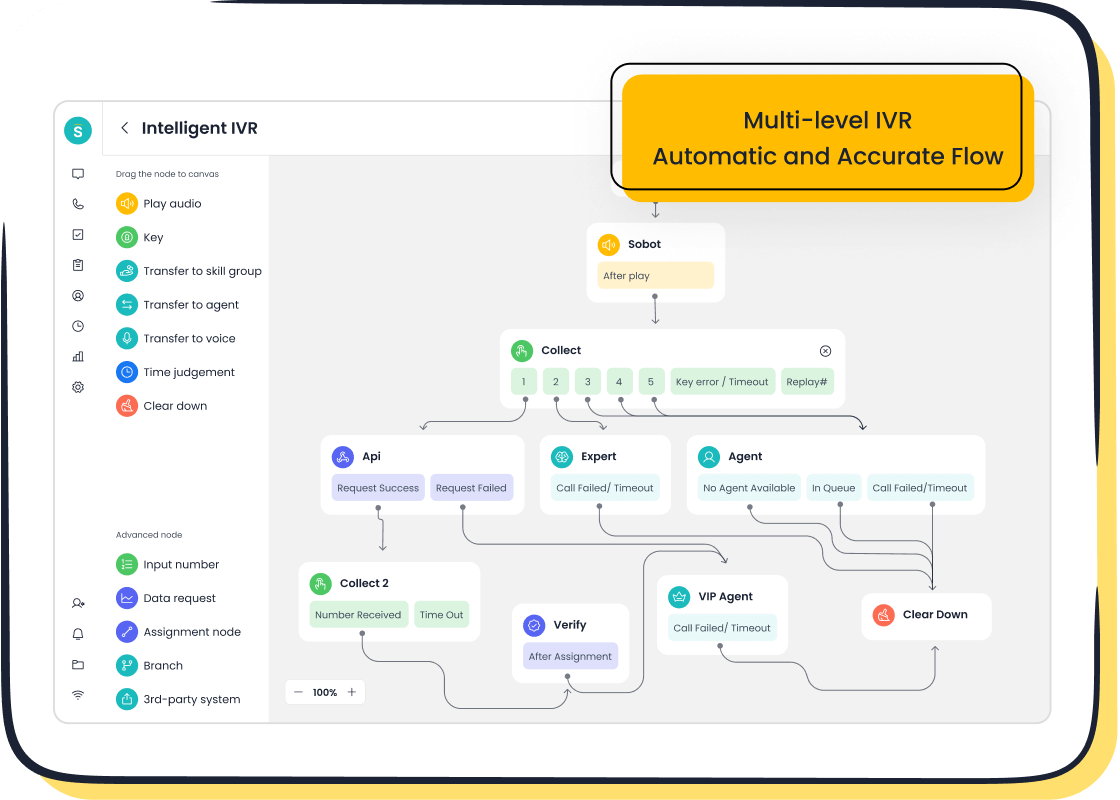
For example, Sobot's Voice/Call Center solution integrates these features seamlessly. It offers intelligent IVR, AI-powered voicebots, and a unified workspace, ensuring agents can deliver top-notch service. With a system uptime of 99.99%, Sobot guarantees reliability and efficiency for businesses of all sizes.
Common Services Provided by Inbound Call Centers
Inbound call centers offer a wide range of services tailored to meet customer needs. These include:
- Customer Support: Agents assist with product-related queries, troubleshooting, and issue resolution.
- Order Processing: Customers can place, modify, or track orders through inbound call center services.
- Technical Support: Specialized agents provide guidance on using products or services, addressing technical challenges.
- Billing and Payment Assistance: Customers receive help with billing inquiries, payment processing, and account management.
- Feedback Collection: Businesses gather valuable insights by actively listening to customer feedback during calls.
These services significantly enhance customer satisfaction. For instance, great contact centers resolve queries quickly and completely, leading to positive feedback and recommendations. Sobot's inbound call center solutions further streamline these services by integrating automation and analytics, enabling businesses to deliver faster and more effective support.
Pro Tip: Monitoring key performance metrics like First Call Resolution (FCR) and Average Handle Time (AHT) can help you assess the efficiency of your inbound call center. Below is a table summarizing some essential metrics:
| Metric | Description |
|---|---|
| Call Abandonment Rate | Percentage of calls where customers hang up before speaking to an agent. |
| Average Handle Time (AHT) | Average time agents spend on each call, including after-call work. |
| First Call Resolution (FCR) | Percentage of calls resolved on the first attempt, indicating efficiency in handling customer issues. |
| Service Level | Percentage of calls answered within a defined time, reflecting responsiveness to customer needs. |
| Cost per Call (CPC) | Average cost incurred for each call handled, indicating operational cost efficiency. |
By leveraging these metrics, you can identify areas for improvement and optimize your inbound call center operations.
How Sobot's Voice/Call Center Enhances Inbound Operations
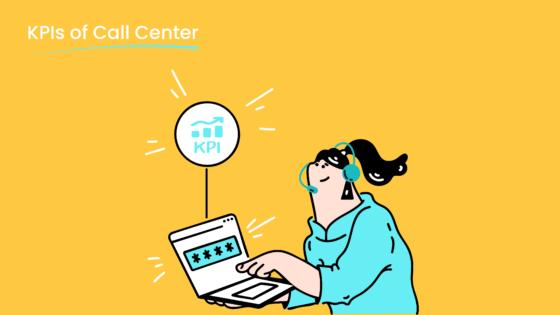
Sobot's Voice/Call Center transforms the way inbound call centers operate by combining advanced technology with user-friendly tools. Whether you're managing customer inquiries, technical support, or billing issues, Sobot equips you with everything needed to deliver exceptional service. Here's how Sobot's solutions can elevate your inbound operations:
1. Intelligent IVR for Seamless Call Routing
Sobot's Intelligent IVR (Interactive Voice Response) system ensures that every call reaches the right agent or department. You can customize greetings, create menus, and route calls effortlessly using a drag-and-drop interface. This feature reduces wait times and improves first-call resolution rates. For example, businesses using Sobot's IVR have reported a 30% improvement in call handling efficiency.
Tip: Use IVR to offer self-service options for common queries like order tracking or account balance checks. This frees up agents to focus on more complex issues.
2. Unified Workspace for Enhanced Agent Productivity
Sobot's unified workspace consolidates customer data, interaction history, and call details into a single dashboard. This allows agents to access all the information they need without switching between systems. With this feature, you can provide faster, more personalized service. Studies show that 73% of customers prefer businesses that remember their past interactions.
3. AI-Powered Voicebots for 24/7 Support
Sobot's AI-powered voicebots handle routine inquiries, such as FAQs or appointment scheduling, with remarkable accuracy. These bots use natural language processing to understand customer intent, ensuring smooth interactions. By automating repetitive tasks, you can reduce agent workload and improve response times. Businesses using Sobot's voicebots have seen a 40% reduction in average handle time.
4. Real-Time Monitoring and Analytics
Sobot provides real-time monitoring tools that let you track key metrics like call volume, agent performance, and customer satisfaction. You can use these insights to identify bottlenecks and optimize your operations. For instance, monitoring the First Call Resolution (FCR) rate helps you measure how effectively your team resolves issues on the first attempt.
| Metric | Benefit |
|---|---|
| First Call Resolution (FCR) | Improves customer satisfaction and reduces repeat calls. |
| Average Handle Time (AHT) | Helps identify areas where agents can improve efficiency. |
| Call Abandonment Rate | Tracks how often customers hang up before speaking to an agent. |
5. Global Number Availability and Time Zone Support
Sobot's platform offers access to phone numbers worldwide, enabling you to provide localized support. Additionally, its time zone support ensures that your team can cater to customers across different regions without delays. This feature is especially valuable for businesses with a global customer base.
Pro Tip: Use Sobot's time zone analysis to schedule agents during peak hours in each region, maximizing efficiency.
6. Reliable and Scalable Infrastructure
With a system uptime of 99.99%, Sobot ensures uninterrupted operations. Its cloud-based infrastructure supports businesses of all sizes, from startups to large enterprises. You can scale your operations effortlessly as your business grows.
Sobot's Voice/Call Center doesn't just enhance inbound call center operations—it redefines them. By integrating intelligent tools like IVR, voicebots, and real-time analytics, you can improve customer satisfaction, reduce costs, and boost efficiency. Ready to take your inbound call center to the next level? Explore Sobot's solutions today: Sobot Voice/Call Center.
What Is an Outbound Call Center?
Definition and Objectives of Outbound Telemarketing
An outbound call center focuses on making outgoing calls to customers or prospects. These calls aim to achieve specific goals, such as generating leads, closing sales, conducting surveys, or following up on previous interactions. Outbound telemarketing serves as a proactive approach to customer engagement, helping businesses expand their reach and build stronger relationships with their audience.
The objectives of outbound telemarketing often include increasing revenue, improving brand awareness, and gathering valuable customer insights. For instance, the Amazon Hybrid Agency grew its monthly revenue to over $100,000 in just five months by prioritizing outbound marketing efforts. This demonstrates how effective outbound strategies can drive measurable business growth. Setting clear goals, knowing your target audience, and preparing a well-structured sales script are essential for achieving success in outbound campaigns.
Key Features of Outbound Call Centers
Outbound call centers rely on advanced tools and strategies to maximize efficiency and effectiveness. Some of the key features include:
- Predictive Dialers: These systems automatically dial numbers and connect agents only when a call is answered, reducing idle time and increasing productivity.
- CRM Integration: Outbound call centers integrate with customer relationship management (CRM) systems to provide agents with detailed customer information, enabling personalized interactions.
- Call Monitoring and Analytics: Supervisors can track metrics like call duration, conversion rates, and agent performance to optimize operations.
- Campaign Management Tools: These tools help plan, execute, and monitor outbound campaigns, ensuring alignment with business objectives.
- Scalability: Outbound call centers can adjust their operations to meet seasonal demands or accommodate business growth.
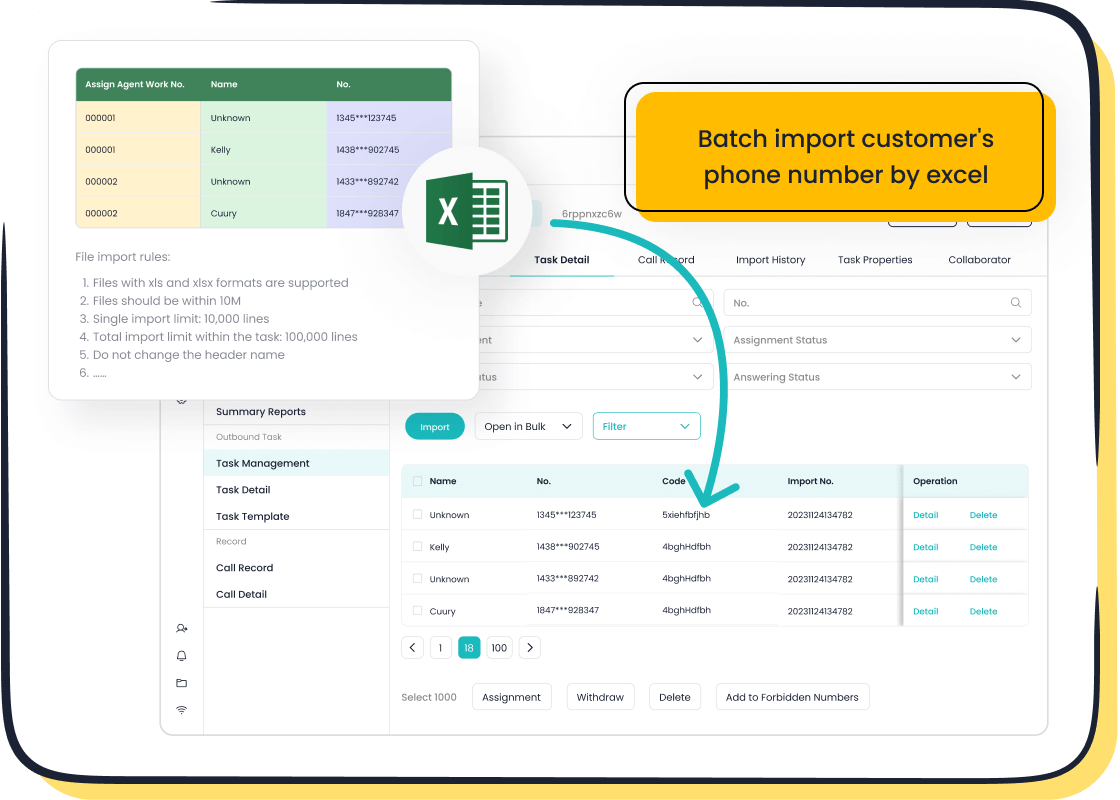
Sobot's Voice/Call Center solution incorporates these features seamlessly. For example, its predictive dialer and CRM integration allow agents to focus on meaningful conversations rather than manual dialing. Additionally, Sobot's real-time analytics provide actionable insights, helping you refine your outbound strategies for better results.
Did You Know? Outbound call centers often achieve higher productivity levels by outsourcing tasks, allowing in-house teams to focus on core business activities.
Typical Services Offered by Outbound Call Centers
Outbound call centers provide a variety of services designed to meet diverse business needs. These include:
- Lead Generation: Agents identify and qualify potential customers, passing high-quality leads to sales teams.
- Sales Calls: Outbound agents promote products or services, aiming to close deals and boost revenue.
- Customer Retention: Follow-up calls help maintain relationships with existing customers, addressing concerns and offering new solutions.
- Market Research: Surveys and feedback collection provide valuable insights into customer preferences and market trends.
- Appointment Setting: Agents schedule meetings between prospects and sales representatives, streamlining the sales process.
For example, businesses using Sobot's outbound call center solutions have reported improved lead-to-transfer rates and higher conversion rates. Sobot's platform supports bulk outbound tasks, enabling you to automate repetitive processes and prioritize high-value leads. With features like global number availability and time zone support, you can reach customers worldwide at the most convenient times.
| Metric | Description |
|---|---|
| Conversion Rate | Measures the percentage of calls achieving a desired outcome, indicating agent proficiency. |
| Call Pickup Rate | Tracks the proportion of outgoing calls that are answered, reflecting effective customer targeting. |
| Average Handling Time (AHT) | Reflects call duration and post-call processing time, impacting customer satisfaction and efficiency. |
| Lead to Transfer Rate | Indicates how many leads are passed to sales teams, crucial for lead generation centers. |
| List Conversion Rate | Evaluates success rates of specific calling lists, important for assessing prospect list quality. |
| First-call Close | Tracks issues or sales closed on the first call, indicating customer satisfaction and agent effectiveness. |
| Customer Satisfaction Score | Direct feedback from customers post-interaction, providing insight into customer perception. |
Outbound call centers play a critical role in driving business growth. By leveraging advanced tools and focusing on customer engagement, you can achieve higher conversion rates and build lasting relationships. Sobot's solutions empower you to optimize every aspect of your outbound operations, ensuring success in a competitive market.
Leveraging Sobot's Voice/Call Center for Outbound Success
Sobot's Voice/Call Center equips you with the tools to transform your outbound call centre into a powerhouse of efficiency and results. By leveraging its advanced features, you can streamline operations, improve agent productivity, and achieve higher conversion rates. Here’s how Sobot helps you succeed in outbound telemarketing.
1. Predictive Dialers for Maximum Efficiency
Sobot's predictive dialer eliminates the time agents spend dialing numbers manually. It connects agents only when a call is answered, reducing idle time and increasing productivity. For example, businesses using predictive dialers report up to a 300% increase in talk time per hour. This feature ensures your outbound call centre operates at peak efficiency, allowing agents to focus on meaningful conversations.
Tip: Use predictive dialers to prioritize high-value leads, ensuring your team spends time on calls that matter most.
2. CRM Integration for Personalized Interactions
Sobot integrates seamlessly with your existing CRM systems, giving agents access to detailed customer profiles. This allows them to tailor their approach during calls, improving the chances of a successful outcome. Studies show that personalized interactions can boost customer satisfaction by 80%. With Sobot, your outbound call centre agents can build stronger connections with prospects.
3. Bulk Outbound Task Automation
Managing large-scale campaigns becomes effortless with Sobot's bulk outbound task feature. You can automate repetitive tasks like follow-ups or appointment reminders, freeing up agents to focus on closing deals. This feature is especially useful for businesses handling high call volumes. For instance, companies using Sobot's automation tools have seen a 25% reduction in operational costs.
4. Real-Time Analytics for Data-Driven Decisions
Sobot provides real-time analytics to help you monitor key metrics like call pickup rates, conversion rates, and agent performance. These insights enable you to identify areas for improvement and optimize your outbound call centre strategies. For example, tracking the lead-to-transfer rate can help you refine your targeting efforts, ensuring better results.
| Metric | Benefit |
|---|---|
| Conversion Rate | Measures the success of your campaigns, helping you adjust strategies. |
| Call Pickup Rate | Indicates the effectiveness of your customer targeting efforts. |
| Lead-to-Transfer Rate | Tracks how many leads are passed to sales teams for follow-up. |
5. Global Reach with Time Zone Support
Sobot's platform offers global number availability and time zone support, enabling you to connect with customers worldwide. This ensures your outbound call centre services are accessible to a diverse audience. By scheduling calls during peak hours in each region, you can maximize engagement and improve outcomes.
Pro Tip: Use Sobot's time zone analysis to identify the best times to reach your target audience, increasing the likelihood of successful interactions.
6. AI-Powered Voicebots for Enhanced Outreach
Sobot's AI-powered voicebots handle routine tasks like survey calls or appointment confirmations. These bots use natural language processing to understand customer intent, ensuring smooth interactions. By automating these tasks, you can reduce agent workload and focus on high-priority calls. Businesses using Sobot's voicebots have reported a 40% improvement in campaign efficiency.
7. Scalable and Reliable Infrastructure
Sobot's cloud-based infrastructure supports businesses of all sizes. Whether you're a startup or a large enterprise, you can scale your outbound call centre operations effortlessly. With a system uptime of 99.99%, Sobot ensures uninterrupted service, allowing you to focus on achieving your goals.
Sobot's Voice/Call Center redefines outbound call centre services by combining advanced technology with user-friendly tools. From predictive dialers to real-time analytics, every feature is designed to help you succeed. Ready to elevate your outbound operations? Explore Sobot's solutions today: Sobot Voice/Call Center.
Comparing Inbound and Outbound Telemarketing Call Centers
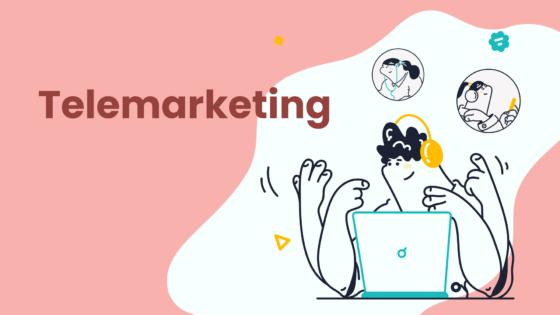
Operational Differences Between Inbound and Outbound Call Centers
Inbound and outbound call centers differ significantly in their operations. Inbound centers focus on receiving calls from customers, often related to support, inquiries, or service requests. Outbound centers, on the other hand, initiate calls to customers or prospects for sales, surveys, or follow-ups. These differences shape their workflows, tools, and objectives.
| Metric | Inbound Call Centers | Outbound Call Centers |
|---|---|---|
| Average Handle Time | 6 minutes | Varies by campaign |
| Call Purpose | Customer support | Sales and surveys |
| Call Volume | High volume of calls | Targeted outreach |
Inbound centers prioritize efficiency in resolving customer interactions, while outbound centers aim to maximize outreach and conversions. For example, Sobot's Voice/Call Center supports both types with features like intelligent IVR for inbound calls and predictive dialers for outbound campaigns, ensuring seamless call center operations.
Customer Experience Impacts of Each Type
The customer experience varies depending on whether the interaction is inbound or outbound. Inbound centers react to customer needs, focusing on problem-solving and satisfaction. Outbound centers proactively reach out, often requiring strategic engagement to avoid being intrusive.
| Aspect | Inbound Call Centers | Outbound Call Centers |
|---|---|---|
| Proactivity | Reactive to incoming calls | Proactive in contacting potential customers |
| Script Usage | Flexible, focused on customer needs | Predetermined scripts aimed at sales |
| Customer Interaction | Engages customers who have a need | Often unsolicited, requiring strategic engagement |
| Goal Orientation | Customer satisfaction and problem resolution | Aggressive sales-driven goals |
Sobot enhances customer experience in both scenarios. Its AI-powered voicebots handle routine inbound queries, while its CRM integration ensures personalized outbound interactions. These tools help businesses balance efficiency with customer satisfaction.
Use Cases for Inbound and Outbound Call Centers
Inbound and outbound call centers serve distinct purposes. Inbound centers excel in customer support, technical assistance, and order processing. Outbound centers shine in lead generation, sales, and market research.
| Aspect | Inbound Call Center | Outbound Call Center |
|---|---|---|
| Primary Function | Handles incoming customer calls | Initiates outgoing calls to customers |
| Focus | Customer service and support | Sales, lead generation, and marketing |
| Nature of Interaction | Reactive (responds to customer needs) | Proactive (initiates contact with potential clients) |
| Agent Skills Required | Problem-solving, empathy | Sales skills, persuasion |
| Typical Services Offered | Technical support, order processing | Telemarketing, surveys, follow-ups |
For example, Sobot's solutions enable businesses to manage both types effectively. Its bulk outbound task automation simplifies large-scale campaigns, while its unified workspace streamlines inbound customer interactions. These features make Sobot a versatile choice for diverse business needs.
What Are Hybrid Telemarketing Call Centers?
Definition and Overview of Hybrid Call Centers
Hybrid telemarketing call centers combine the strengths of inbound and outbound operations into a single, unified system. These centers handle both incoming customer inquiries and outgoing calls for sales, surveys, or follow-ups. By integrating these functions, hybrid call centers provide businesses with greater flexibility and efficiency.
In a hybrid model, agents can switch between inbound and outbound tasks based on demand. For example, during peak hours, agents may focus on answering customer support calls. During quieter periods, they can shift to outbound activities like lead generation or appointment setting. This adaptability ensures optimal resource utilization and enhances customer satisfaction.
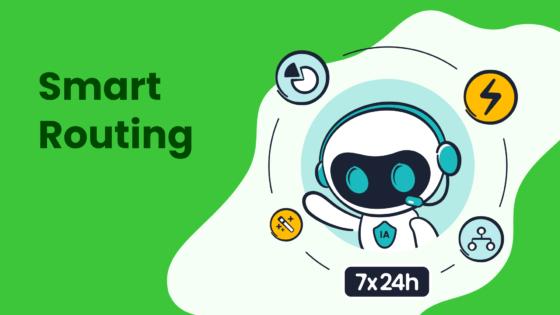
Hybrid call centers also rely on advanced tools to manage their dual operations. Sobot's Voice/Call Center solution is an excellent example. It offers features like intelligent call routing, bulk outbound task automation, and real-time analytics, making it easier to manage both inbound and outbound workflows seamlessly.
How Hybrid Call Centers Combine Inbound and Outbound Operations
Hybrid call centers integrate inbound and outbound methods through smart technology and strategic planning. Key metrics like call routing efficiency, agent productivity, and customer satisfaction scores help monitor and optimize these operations.
| Metric | Description |
|---|---|
| Call Routing Efficiency | Measures how effectively inbound calls are directed to the appropriate agents. |
| Agent Productivity | Evaluates the number of calls handled by agents, indicating their efficiency in a hybrid model. |
| Customer Satisfaction Score | Assesses customer feedback on their experience, crucial for both inbound and outbound interactions. |
Sobot's platform excels in this area. Its intelligent IVR system ensures inbound calls reach the right agents quickly, while its predictive dialers streamline outbound campaigns. This dual functionality allows businesses to maintain high service standards while achieving sales and marketing goals.
Tip: Use real-time analytics to track agent performance and identify areas for improvement. This data-driven approach ensures your hybrid call center operates at peak efficiency.
Advantages of Hybrid Call Centers for Diverse Business Needs
Hybrid call centers offer several benefits that make them ideal for businesses with varied requirements:
- Improved Resource Utilization: Agents can switch between inbound and outbound tasks, ensuring no downtime during low call volumes.
- Enhanced Customer Experience: Combining inbound support with outbound engagement creates a seamless customer journey.
- Cost Efficiency: A single hybrid system reduces the need for separate teams and infrastructure, lowering operational costs.
- Scalability: Hybrid models adapt easily to changing business needs, whether you're scaling up for a product launch or managing seasonal demand.
- Better Performance Metrics: Hybrid QA metrics, such as resolution rates and customer feedback, provide a comprehensive view of service quality.
Research supports these advantages. A Stanford University study found that hybrid call center employees working remotely showed a 13% performance increase due to fewer breaks and higher efficiency. Flexible work arrangements also reduced employee attrition by 50%, highlighting the long-term benefits of hybrid models.
Sobot's solutions align perfectly with these needs. Its unified workspace and AI-powered tools enable businesses to deliver exceptional service while optimizing costs. Whether you're managing inbound inquiries or outbound campaigns, Sobot ensures your hybrid call center operates smoothly.
Pro Tip: Establish clear KPIs for your hybrid call center. Metrics like customer satisfaction and agent productivity will help you measure success and drive continuous improvement.
Sobot's Role in Supporting Hybrid Call Center Solutions
Sobot empowers businesses to manage hybrid call centers with ease. Its advanced tools and intelligent features allow you to handle both inbound and outbound operations seamlessly. Whether you aim to enhance customer support or boost sales, Sobot provides the flexibility and efficiency you need.
1. Unified Workspace for Streamlined Operations
Sobot’s unified workspace consolidates all customer interactions into a single platform. Agents can switch between inbound and outbound tasks without losing context. This feature ensures smooth transitions and reduces downtime. For example, businesses using Sobot have reported a 25% increase in agent productivity by eliminating the need to toggle between systems.
Tip: Use Sobot's unified workspace to provide personalized service by accessing customer history instantly.
2. Intelligent IVR and Predictive Dialers
Sobot’s intelligent IVR system routes inbound calls to the right agents, while its predictive dialers optimize outbound campaigns. These tools ensure that your hybrid call center operates efficiently. Predictive dialers alone can increase agent talk time by up to 300%, allowing you to focus on meaningful conversations.
3. Real-Time Analytics for Better Decision-Making
Sobot offers real-time analytics to track key metrics like call volume, agent performance, and customer satisfaction. These insights help you identify areas for improvement and optimize your hybrid call center strategy. For instance, monitoring First Call Resolution (FCR) rates can improve customer satisfaction significantly.
| Metric | Benefit |
|---|---|
| First Call Resolution (FCR) | Enhances customer satisfaction by resolving issues on the first attempt. |
| Agent Productivity | Tracks efficiency in handling both inbound and outbound tasks. |
4. Scalability and Global Reach
Sobot supports businesses of all sizes with its scalable infrastructure. Its global number availability and time zone support enable you to serve customers worldwide. This makes Sobot an ideal choice for businesses with diverse customer bases.
Pro Tip: Leverage Sobot’s time zone analysis to schedule calls during peak hours in each region.
Sobot’s hybrid call center solutions combine cutting-edge technology with user-friendly tools. By integrating features like intelligent IVR, predictive dialers, and real-time analytics, Sobot helps you deliver exceptional service while achieving your business goals. Ready to transform your hybrid call center? Explore Sobot’s solutions today: Sobot Voice/Call Center.

Choosing the Right Call Center Solution for Your Business
Factors to Consider When Selecting a Call Center Type
Choosing the right call center solution depends on your business needs and goals. You should evaluate factors like operational efficiency, technology adoption, and customer satisfaction metrics. For example, predictive dialing and routing technologies can reduce average handling time, while AI tools improve performance tracking. Metrics such as Net Promoter Score (NPS) and Customer Satisfaction (CSAT) help measure service quality effectively.
When comparing options, look for features that align with your priorities. Here’s a quick comparison of popular call center solutions:
| Feature | Salesforce Cloud | Zendesk Talk | CXone |
|---|---|---|---|
| Call Logging | Yes | Yes | Yes |
| Monitoring | Yes | Yes | Yes |
| Call Recording | Yes | Yes | Yes |
| Real-time Reporting | Yes | Yes | Yes |
| Automated Reporting | Yes | Yes | Yes |
| Customer Surveys | N/A | Yes | N/A |
| Voice Analytics | N/A | Yes | N/A |
| AI Integration | N/A | N/A | Yes |
Sobot’s cloud-based call center offers similar features, including AI-powered tools and real-time analytics, ensuring your business stays ahead in customer service.
Matching Call Center Services to Business Goals
Aligning call center services with your business objectives requires setting measurable goals. For instance, you might aim to increase your customer satisfaction score from 75% to 90% within a month. This approach allows you to monitor progress and adjust strategies as needed.
Inbound call centers excel in customer service tasks like resolving inquiries and processing orders. Outbound centers focus on sales, lead generation, and surveys. Hybrid models combine both, offering flexibility to meet diverse needs. Sobot’s solutions integrate inbound and outbound capabilities, enabling you to achieve goals like improving first-call resolution rates or reducing operational costs.
Tip: Use analytics tools to track metrics like Average Handling Time (AHT) and Customer Effort Score (CES). These insights help refine your strategies and improve customer satisfaction.
How Sobot's Voice/Call Center Aligns with Business Objectives
Sobot’s Voice/Call Center supports your business goals by enhancing operational efficiency and customer experience. Its AI-powered voicebots automate routine tasks, freeing call center agents to focus on complex interactions. Predictive analytics proactively address customer needs, boosting loyalty and satisfaction.
For example, Sobot’s generative AI automates documentation, reducing agent workload. Conversational AI maintains context during interactions, ensuring personalized service. Businesses using Sobot have reported up to a 30% reduction in customer support costs, allowing reinvestment in growth initiatives.
| AI Technology | Business Objective Impact | Evidence Source |
|---|---|---|
| Generative AI | Automates documentation, allowing human agents to focus on complex interactions. | Customer Success thread |
| Conversational AI | Enhances customer interactions by maintaining context and understanding nuances. | Latest advancements in NLP |
| Predictive Analytics | Proactively addresses customer needs, improving customer loyalty and satisfaction. | Sobot’s analysis |
Sobot’s cloud-based call center ensures scalability and reliability with a 99.99% uptime. Its global number availability and time zone support make it ideal for businesses with international customers. By leveraging Sobot’s solutions, you can align your call center operations with measurable business goals and drive success.
Inbound, outbound, and hybrid call centers each serve unique purposes. Inbound centers focus on resolving customer issues, outbound centers drive sales and engagement, while hybrid models combine both for flexibility. Choosing the right type depends on your business goals. Aligning operations with these goals ensures better efficiency and customer satisfaction. Sobot’s advanced solutions, like AI-powered voicebots and real-time analytics, help you achieve this alignment. With tools designed to enhance productivity and service quality, Sobot empowers businesses to deliver exceptional results.
FAQ
What is the difference between telesales and telemarketing?
Telesales focuses on closing sales through direct calls, while telemarketing involves broader activities like lead generation, surveys, and customer engagement. For example, telesales agents might sell a product, whereas telemarketing agents might gather feedback or schedule appointments.
How do call centers handle incoming and outgoing calls?
Call centers use advanced tools like intelligent IVR for routing incoming calls and predictive dialers for outgoing calls. For instance, Sobot’s Voice/Call Center ensures seamless management of both types, enhancing customer support and engagement.
Why is lead generation important in outbound call centers?
Lead generation identifies potential customers, creating opportunities for sales teams. It drives revenue and builds a customer base. For example, businesses using Sobot’s outbound solutions report higher conversion rates due to targeted outreach.
How does business process outsourcing benefit call centers?
Business process outsourcing reduces costs and improves efficiency by delegating call center operations to specialized providers. This allows businesses to focus on core activities while ensuring high-quality customer interactions.
Can AI improve telesales performance?
AI enhances telesales by automating repetitive tasks, analyzing customer data, and providing real-time insights. Sobot’s AI-powered voicebots, for example, reduce average handling time and improve customer satisfaction by handling routine inquiries efficiently.
See Also
Understanding The Efficiency Of Call Center Automation
Defining The Concept Of A Remote Call Center
Essential Practices For Quality Management In Call Centers
Exploring The Services And Advantages Of Medical Call Centers
